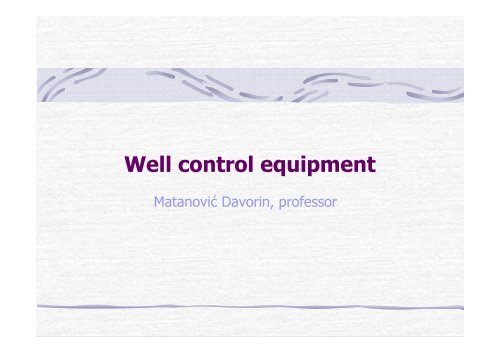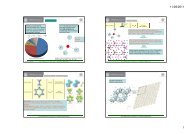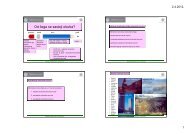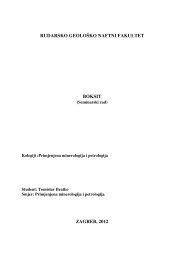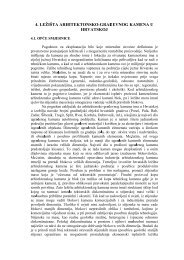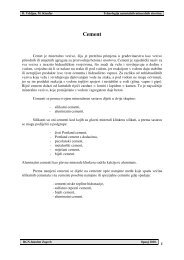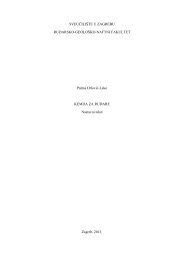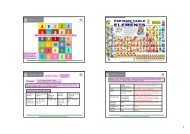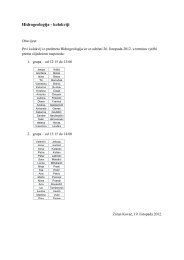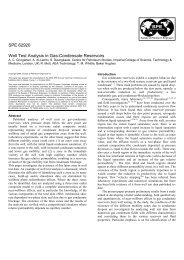Create successful ePaper yourself
Turn your PDF publications into a flip-book with our unique Google optimized e-Paper software.
<strong>Well</strong> <strong>control</strong> <strong>equipment</strong><br />
Matanović Davorin, professor
Blowout Preventers<br />
Blowout preventers (BOPs), in conjunction<br />
with other <strong>equipment</strong> and techniques, are<br />
used to close the well in and allow the<br />
crew to <strong>control</strong> a kick before it becomes a<br />
blowout.<br />
Blowout preventer <strong>equipment</strong> should be<br />
designed to:<br />
1. Close the top of the hole.<br />
2. Control the release of fluids.<br />
3. Permit pumping into the hole.<br />
4. Allow movement of the inner string of pipe.
Blowout Preventers<br />
These requirements mean that there;<br />
must be enough casing in the well to<br />
provide an anchor for the wellhead<br />
<strong>equipment</strong>,<br />
there must be provision for <strong>equipment</strong> to<br />
close the hole with or without pipe in well,<br />
the <strong>equipment</strong> must provide for the<br />
attachment of lines for bleeding off<br />
pressure, and<br />
it must allow pumping into the working<br />
string or annulus.
Blowout Preventers<br />
Basic types of blowout preventers<br />
on drilling rig are:<br />
annular preventers<br />
ram preventers<br />
rotational preventers and<br />
diverters
Blowout Preventers<br />
The recommended component<br />
codes for designation of BOP stack<br />
arrangements are as follows:
Blowout Preventers<br />
BOP components are typically<br />
described upward from the<br />
uppermost piece of the<br />
permanent wellhead<br />
<strong>equipment</strong>, or from the bottom<br />
of the BOP stack:<br />
10K – 13 5/8 – SRRA<br />
This BOP stack would be rated<br />
10000 psi (69 MPa) working<br />
pressure, would have a<br />
through bore of 13 5/8 inches<br />
(34,61 cm), and would be<br />
arranged according to picture.
Blowout Preventers
In the BOP stack they are<br />
always positioned in such<br />
way, that annular preventer<br />
is the working preventer<br />
positioned on the top of the<br />
stack, and ram preventer is<br />
on the bottom as the<br />
backup.<br />
Working preventer is always<br />
positioned far from the<br />
source of danger, to be in<br />
position to change it if fails.
BOPs Rating<br />
Any assembly of blowout prevention<br />
<strong>equipment</strong> can be rated by the lowest<br />
pressure item in the hookup;<br />
whether it is casing,<br />
casing head,<br />
preventers, or<br />
other fitting primarily exposed to well<br />
pressure.
BOPs Rating<br />
The bursting pressure of the casing will<br />
often be the determining factor for<br />
rating the working pressure of the<br />
assembly.<br />
API Bulletin D 13 gives the pressure<br />
ratings for blowout preventer<br />
<strong>equipment</strong>:
API Class<br />
2 M<br />
3 M<br />
5 M<br />
10 M<br />
15 M<br />
BOPs Rating<br />
Working pressure<br />
10 5 Pa (psi)<br />
138 (2000)<br />
207 (3000)<br />
345 (5000)<br />
689 (10000)<br />
1034 (15000)<br />
Service<br />
Condition<br />
light duty<br />
low pressure<br />
medium<br />
pressure<br />
high pressure<br />
extreme<br />
pressure
Annular-type preventers<br />
employ a ring of reinforced<br />
synthetic rubber as a packing<br />
unit that surrounds the well<br />
bore to effect shutoff<br />
In the full-open position, the<br />
inner diameter of the packing<br />
unit equals the diameter of the<br />
preventer bore.<br />
A system for squeezing the<br />
ring of packing lets the<br />
operator reduce the diameter<br />
until it engages the pipe, tool<br />
joint, kelly or the full inner<br />
diameter of the preventer.<br />
The only way to close annulartype<br />
of preventers is by use of<br />
hydraulic pressure.<br />
Annular-type<br />
preventer (Hydril)
Cutaway view of the blowout<br />
preventer can help to show the<br />
main parts:<br />
body,<br />
cover,<br />
packing element, and<br />
operating cylinder.<br />
The pressure of hydraulic fluid<br />
introduced under the piston (A)<br />
produces lifting power that<br />
raises the operating cylinder.<br />
The tapered bowl of operating<br />
cylinder compresses the<br />
packing element to make the<br />
annular shutoff.<br />
Pumping the hydraulic fluid in<br />
opposite direction (B) forces<br />
the operating cylinder<br />
downward, thus permitting the<br />
packing unit to open by<br />
expansion.<br />
Annular-type<br />
preventer (Hydril)<br />
A<br />
B
Although initial closure of the<br />
packing unit is obtained by<br />
hydraulic pressure from an<br />
external source, well<br />
pressure will increase sealing<br />
effect and thus insure<br />
positive closure under high<br />
well pressure.<br />
The preventer is normally<br />
operated by a fluid pressure<br />
of 103 10 5 Pa (1500 psi).<br />
A pressure regulator should be<br />
employed to insure the lowest<br />
closing pressure to permit<br />
slight leakage of well fluid<br />
around the drill pipe when<br />
rotating or stripping in or out of<br />
the hole.<br />
A small amount of fluid leaking<br />
past the pipe will lubricate and<br />
cool the packing unit.<br />
Annular-type<br />
preventer (Hydril)
Annular-type preventer<br />
(Shaffer)
The pressure of<br />
hydraulic fluid<br />
introduced under the<br />
piston (A) produces<br />
lifting power that<br />
raises the operating<br />
cylinder.<br />
The tapered bowl of<br />
operating cylinder<br />
compresses the<br />
packing element to<br />
make the annular<br />
shutoff.<br />
A
Packing element<br />
Packing element<br />
(Hydril)<br />
Note the steel finger<br />
inserts which strengthen<br />
and reinforce the resilient<br />
packing material.<br />
Packing element<br />
(Shaffer)
Natural rubber is used with<br />
water based mud, and<br />
working temperatures from –<br />
35 °C to 107 °C.<br />
High duration and reliability.<br />
Identification code is R or NR<br />
with serial number and black<br />
color on the upper edge.<br />
Nitrile rubber (synthetic<br />
components in natural<br />
rubber), is used with oil<br />
based muds or with muds<br />
that have oil based additives,<br />
and working temperatures<br />
from – 7 °C to 88 °C.<br />
Identification code is S or NBR<br />
with serial number and red color<br />
on the upper edge.<br />
Neoprene rubber is<br />
used with oil based<br />
muds and low<br />
temperatures from – 35<br />
°C to 77 °C.<br />
Higher duration than<br />
natural rubber with<br />
better elasticity on lower<br />
temperatures than nitrile<br />
rubbers.<br />
Identification code is N<br />
or CR with serial number<br />
and green color on the<br />
upper edge.
They close the<br />
annular space outside<br />
the string of pipe in a<br />
well or open hole, by<br />
moving rams from a<br />
retracted position<br />
clear of the bore into<br />
a position where they<br />
close around the<br />
pipe.<br />
Rams operate in pairs<br />
and seal space below<br />
them closed.<br />
Ram-type<br />
preventers
Ram-type<br />
preventers<br />
Pipe rams are provided<br />
with semicircular<br />
openings which match<br />
the diameter of the pipe<br />
sizes for which they are<br />
designed.<br />
It is absolutely vital that the<br />
pipe rams in a preventer fit<br />
the drill pipe or tubing in the<br />
use, and all concerned must<br />
be certain in this regard at all<br />
times.<br />
If more than one size of drill<br />
pipe is in the hole, most<br />
operators require a second<br />
ram preventer in the stack.
Ram-type preventers<br />
Blank units which will close on the open hole are commonly<br />
termed “blind” rams.<br />
Blind rams will flatten drill pipe or tubing if they are inadvertently<br />
closed in them, and the driller should always be certain not to<br />
operate the blind rams when the pipe is in the hole.<br />
Ram-type preventers were originally manually operated, but most<br />
preventers of this type today are closed and opened by hydraulic<br />
means, using fluid that is under 35 10 5 Pa (500 psi) to 103 10 5 Pa<br />
(1500 psi) of pressure.<br />
Most ram-type preventers are provided with screws to lock the rams<br />
in the closed position.<br />
Manually operated preventers are similar to hydraulic units, except<br />
for the hydraulic cylinders.
Shaffer ram-type hydraulic blowout preventer<br />
with automatic lock<br />
On the picture (left) there is the closing<br />
system with ram in opened position, and<br />
on the picture (right) is the same system<br />
in fully closed position.
Closing element of the<br />
ram-type preventer<br />
consists of three<br />
parts:<br />
rubber (elastomer),<br />
steel block, and<br />
ram holder.<br />
Closing<br />
element
It is also possible<br />
(available), to use<br />
rams that can be<br />
closed around<br />
different drill pipe<br />
diameters: from 88,9<br />
mm (3 ½˝) to 127,0<br />
mm (5");<br />
That is just to avoid<br />
the necessity to change<br />
the rams in preventer,<br />
when the drill pipe<br />
diameter is changed.
Blind rams can also<br />
be used as drill<br />
pipe cutters.<br />
The use of blind<br />
rams for such<br />
purposes is<br />
acceptable only<br />
when there is the<br />
treat of open<br />
blowout, and<br />
nothing else can be<br />
done.
Rotational preventers are<br />
used:<br />
For drilling in layers that are<br />
suspected to cause possible<br />
kick off.<br />
When drilling on the balance<br />
or under balanced (drilling<br />
the rocks of great<br />
permeability or porosity; to<br />
avoid pollution with mud).<br />
When using indirect<br />
circulation.<br />
When the drilling is done<br />
using air or gas.<br />
Rotational<br />
preventers
Rotationil preventers<br />
Rotational preventer is always positioned<br />
at the top of the stack above annular<br />
preventer.<br />
It is used when differential pressure at<br />
the wellhead does not exceed 34,5 10 5<br />
Pa (500 PSI),<br />
and in such situation it must enable<br />
manipulation (withdrawing and embedding)<br />
and rotation of drill stem through the closed<br />
working (sealing) element.
Rotational part of the<br />
preventer is mounted on<br />
the drill pipe by use of<br />
unique prong, and is<br />
posted on the working<br />
floor.<br />
When needed, the<br />
rotational head is<br />
connected to the housing,<br />
mounted on the top of<br />
annular preventer.<br />
Rotational sleeve is rotated<br />
by the rotation of the kelly,<br />
and is at the same time<br />
rotating the working rubber<br />
element on the cylindrical<br />
bearing.
Diverters as the name says<br />
are used to, direct eventual<br />
invaded higher pressure<br />
fluid from the well, to the<br />
cleaning and reservoir<br />
system, and not to danger<br />
the workers on the working<br />
platform of the derrick.<br />
That is accomplished by closing<br />
the working sealing element of<br />
the diverter and opening<br />
diverter pipe lines whose<br />
diameter is from 101,6 mm (4")<br />
to 304,8 mm (12").<br />
There are usually two relief<br />
lines, and one that is opened<br />
must be always in the<br />
direction that provide that<br />
gas or dangerous fluid will be<br />
carried away of the rig floor.<br />
Diverters
The line is opened at the<br />
same moment the working<br />
sealing element is closed.<br />
It is important because failing<br />
to do so it is possible to<br />
fracture shallow rocks and the<br />
gas or high pressure fluid can<br />
rupture to the surface near or<br />
far from the rig un<strong>control</strong>led.<br />
That is especially dangerous<br />
off-shore when using the<br />
platform that is standing on<br />
the see-bottom on the legs,<br />
because the material can be<br />
washed over below one leg,<br />
and the platform can turn<br />
over.
Diverters are mainly used in off-shore<br />
drilling.<br />
On shore they are rare in use: mainly in<br />
drilling for the conductor when the well<br />
is to be with total depth over 6000 m.<br />
That is because there is not other<br />
preventer that will enable the passage<br />
of the bit of 660,4 mm (26“) diameter,<br />
that is used to drill the hole for casing<br />
with diameter of 508 mm (20“).
Inside preventers<br />
An:<br />
kelly cock<br />
inside blowout preventer,<br />
drill pipe float valve, or<br />
drop in check valve<br />
should be available for use when stripping the drill<br />
string into or out of the hole.<br />
The valve(s), sub(s), or profile nipple should<br />
be equipped to screw into any drill string<br />
member in use.
Kelly valves (kelly cocks)<br />
An upper kelly valve is installed between the<br />
swivel and the kelly.<br />
A lower kelly valve is installed imediatelly<br />
below the kelly.<br />
Upper kelly has on the top the left-hand screw<br />
to avoid un<strong>control</strong>led screw of, and on the<br />
bottom there will be a right-hand screw.
Inside Blowout<br />
preventer<br />
The inside blowout preventer protects<br />
the rotary swivel, drilling hose,<br />
standpipe and mud pumps when a kick<br />
occurs through the drill string.<br />
It will effectively seal against the pressures<br />
up to 69 MPa.<br />
Permits downward flow of circulation fluid<br />
through the drill pipe while preventing<br />
upward flow after circulation stops.<br />
Always on the working floor near the rotary<br />
table.
In Shaffer type<br />
kelly valve, closing<br />
element is a (roller)<br />
cylinder.<br />
Sealing is achieved<br />
by rubber to metal<br />
contact.
Drill string safety valve<br />
A spare drill pipe safety<br />
valve should be readily<br />
available (i.e. stored in<br />
open position with wrench<br />
accessible) on the rig floor<br />
at all times.<br />
This valve or valves should<br />
be equipped to screw into<br />
any drill string member in<br />
use.<br />
The outside diameter of the<br />
drill pipe safety valve should<br />
be suitable for running in the<br />
hole.
Drill string float valves<br />
A float valve is placed in the drill string<br />
to prevent upward flow of fluid or gas<br />
inside the drill string.<br />
This is a special type of back pressure<br />
check valve.<br />
When in good working order it will prohibit<br />
backflow and a potential blowout through<br />
the drill string.
The drill string float valve is usually<br />
placed in the lower-most portion of the<br />
drill string, between two drill collars or<br />
between the drill bit and drill collar.<br />
Since the float valve prevents the drill string<br />
from being filled with fluid through the bit as<br />
it is run into the hole, the drill string must be<br />
filled from the top, at the drill floor, to<br />
prevent collapse of the drill pipe.
Flapper-type float valve<br />
The flapper-type float valve offers<br />
the advantage of having the<br />
opening through the valve that is<br />
approximately the same inside<br />
diameter as that of the tool joint.<br />
This valve will permit the passage of<br />
balls, or go-devils, which may be<br />
required for operation of tools inside<br />
the drill string below the float valve.
Spring-loaded float valves<br />
The spring-loaded ball, or dart, and seat float valve offers<br />
the advantage of an instantaneous and positive shut off<br />
of backflow through the drill string.<br />
These valves are not full-bore and thus cannot sustain long<br />
duration or high volume pumping of drilling or kill fluid.<br />
A wireline retrievable valve that seals in a profiled body that has<br />
an opening approximately the same inside diameter as that of<br />
tool joint may be used to provide a full-open access, if needed.
<strong>Well</strong> head<br />
• The wellhead includes<br />
all <strong>equipment</strong> placed on<br />
top of the well to support<br />
tubulars, provide seals,<br />
and <strong>control</strong> the paths<br />
and flow rates of fluids.<br />
− All wellheads include at<br />
least;<br />
− one casing head and casing<br />
hanger,<br />
− a tubing head and tubing<br />
hanger, and a Christmas<br />
tree.
<strong>Well</strong> head<br />
• Casing heads are<br />
attached to surface<br />
casing or to another<br />
casing head to<br />
provide a hanging<br />
point for the next<br />
string of casing.<br />
− If there is one casing<br />
head, it is welded or<br />
screwed (depending on<br />
diameter) to the surface<br />
casing, and the<br />
production casing is hung<br />
from it.
− If more than<br />
one casing<br />
string is used<br />
inside the<br />
surface casing,<br />
then more than<br />
one casing<br />
head may be<br />
needed.<br />
− An<br />
intermediate<br />
casing head<br />
may be added<br />
with each new<br />
casing string<br />
until the<br />
production<br />
casing has<br />
been hung.<br />
<strong>Well</strong> head
<strong>Well</strong> head<br />
The top of a casing head<br />
has a cone-shaped bowl<br />
that holds the casing<br />
hanger.<br />
A casing hanger is a set of<br />
slips that grips and supports<br />
a casing string.<br />
Metal and rubber packing<br />
rings fit over the slips to<br />
complete the casing hanger<br />
assembly and provide an<br />
annular seal.<br />
Threaded or flanged outlets<br />
on the side of the casing<br />
head allow access to the<br />
sealed annulus for pressure<br />
gauges that warn of casing<br />
leaks.
Three types of end and outlet flanges are <strong>control</strong>led by API<br />
Spec. 6A. (10-4)<br />
That are 6B and 6BX flanges that can be used as integral, blind or<br />
weld neck flanges.<br />
Type 6B may also be used as threaded flanges.<br />
Some type of 6BX blind flanges may also be used as test flanges.<br />
The third type – segmented flanges are used on dual<br />
completion wells and are integral with the <strong>equipment</strong>.<br />
X – diameter of hub, m<br />
B – maximum bore, m<br />
T – flange thickness, m<br />
K – diameter of raised<br />
face, m<br />
BC – diameter of bolt<br />
circle, m<br />
OD – outside flange<br />
diameter, m
The bolt length is established using:<br />
L CSB =A+n<br />
Where:<br />
L CSB – calculated stud length (effective thread length,<br />
excluding end points), m<br />
L SSB - specified stud bolt length (which is L CSB rounded<br />
off to the nearest commercially available length), m
A=2⋅(T+0,5⋅t+d)+S<br />
A - stud bolt length exclusive of negative length<br />
tolerance, m<br />
T – flange thickness, m<br />
t – plus tolerance for flange thickness, m<br />
d – nut thickness (equals nominal bolt<br />
diameter), m<br />
S – flange face standoff (for BX<br />
assemblies it is zero), m<br />
n – negative tolerance on bolt length :<br />
1,5875 mm (1/16") for lengths up to 304,8<br />
mm (12"); 3,175 mm (1/8") for lengths over<br />
304,8 mm (12") to 457,2 mm<br />
(18"); 6,35 mm (1/4") for lengths over<br />
457,2 mm (18"), m
Type R and RX gaskets are<br />
used on 6B flanges.<br />
Only type BX gaskets are to<br />
be used with 6BX flanges.<br />
RX and BX provide a<br />
pressure energized seal but<br />
are not interchangeable .<br />
E – groove depth, m<br />
F – groove width, m<br />
R 2 – radius in groove, m<br />
R 1 – radius in ring (octagonal<br />
ring), m<br />
H,B – ring height<br />
P – standard ring or groove<br />
diameter, m<br />
A – width of ring, m<br />
C – width of flat (octagonal<br />
ring), m<br />
Gasket and<br />
groove type "R"
Note! The pressure passage hole in the RX ring has a hole<br />
whose centerline is located at midpoint of dimension ˝C˝.<br />
Hole diameter is 1,524 mm (0,06 in) for rings RX-82 to RX-<br />
85, 2,286 mm (0,09 in) for rings RX-86 and RX-87, and 3,048<br />
mm (0,12 in) for rings RX-88 to RX-91.(10-27)<br />
Ring and groove "RX" Ring and groove "BX"
Sealing systems<br />
Pack off system consists of lip seal packing and two<br />
metal packing supports.<br />
Each crossover spool, multistage crossover spool,<br />
crossover adapter; shall have at least one restricted area<br />
pack off.
Testing and Maintenance of surface BOP stack<br />
and well <strong>control</strong> <strong>equipment</strong><br />
The purpose for various test programs on<br />
drilling well <strong>control</strong> <strong>equipment</strong> is to verify:<br />
1. That specific functions are operationally ready.<br />
2. The pressure integrity of the installed<br />
<strong>equipment</strong>.<br />
3. The <strong>control</strong> system and BOP compatibility
Testing and Maintenance of surface BOP stack<br />
and well <strong>control</strong> <strong>equipment</strong><br />
All operational components of the BOP<br />
<strong>equipment</strong> should be functioned at least once a<br />
weak to verify the component’s intended<br />
operations, Function tests may or may not<br />
include pressure tests.<br />
They should be alternated from the driller’s panel and<br />
from mini-remote panels, if on location.<br />
Actuation times should be recorded as a data base for<br />
evaluating trends.
When testing<br />
BOP stack the<br />
hole is separated<br />
by the use of so<br />
called “cup<br />
tester”.
Pressure tests<br />
All blowout prevention components that<br />
my be exposed to well pressure should<br />
be tested first to a low pressure of 1,38<br />
to 2,1 MPa (200 to 300 psi) and then to<br />
a high pressure.<br />
When performing the low pressure test, do<br />
not apply a higher pressure and bleed<br />
down to the low test pressure.<br />
A stable low test pressure should be<br />
maintained for at least 5 minutes.
Pressure tests<br />
The initial high pressure test on components<br />
that could be exposed to well pressure (BOP<br />
stack, choke manifold and choke lines) should<br />
be to the rated working pressure of the ram<br />
BOP’s or to the rated working pressure of the<br />
wellhead that the stack is installed on,<br />
whichever is lower.<br />
Initial pressure tests are defined as those<br />
tests that should be performed on location<br />
before the well is spaded or before the<br />
<strong>equipment</strong> is put into operational service.
Pressure tests<br />
Diverter systems are typically pressure<br />
tested to a low pressure only.<br />
Annular BOPs, with a joint of drill pipe<br />
installed, may be tested to the pressure<br />
applied to the ram BOPs or to a<br />
minimum of 70% of the annular<br />
preventer working pressure, whichever<br />
is the lesser
Pressure tests<br />
The lower kelly valves, kelly, kelly cock,<br />
drill pipe safety valves, inside BOPs and<br />
top drive safety valves, should be tested<br />
with water pressure applied from below<br />
to a low pressure of 1,38 to 2,1 MPa<br />
(200 to 300 psi) and then to the rated<br />
working pressure.
Pressure tests<br />
For instance: The producer of ram-type<br />
preventer (18 3/4“; 15000 psi) defines test<br />
pressures as:<br />
around drill pipes 800 to 1100 psi; from 5,5 to 7,6<br />
MPa,<br />
full bore rams 800 to 1100 psi; from 5,5 to 7,6<br />
MPa,<br />
cutting rams 1100 to 1400 psi; od 7,6 to 9,7 MPa.
Pressure tests<br />
Subsequent high pressure tests on the well<br />
<strong>control</strong> components should be to a pressure<br />
greater than the maximum anticipated surface<br />
pressure, but not to exceed the working<br />
pressure of the ram BOPs.<br />
The maximum anticipated pressure should be<br />
determined by the operator based on specific<br />
anticipated well conditions..
The pressure test<br />
performed on hydraulic<br />
chambers of annular BOPs,<br />
connectors, hydraulic lines<br />
and manifolds, should not<br />
exceed (should be at least)<br />
10,3 MPa (1500 psi).<br />
Initial pressure tests on<br />
hydraulic chambers of ram<br />
BOPs and hydraulically<br />
operated valves should be<br />
to the maximum operating<br />
pressure recommended by<br />
the manufacturer.
For annular preventers closing pressures differ<br />
because of the higher closing area.<br />
Figure shows closing pressures for annular<br />
preventers depending on working pressure and<br />
closing area (full closing or around specific pipe<br />
diameter).
Pressure testing of<br />
an annular<br />
preventer
Pressure testing of<br />
an ram-type<br />
preventer, closing<br />
around the pipe<br />
body.
Hydraulic <strong>control</strong> fluids<br />
Preventers are activated by the use of special<br />
hydraulic <strong>control</strong> fluid. The fluid must:<br />
not freeze on low temperatures (temperature range from 84 °C to<br />
–46 °C)<br />
lubricate moving parts and avoid wearing out<br />
not cause corrosion<br />
disperse in salt or fresh water and not pollute or<br />
contaminate.<br />
For such purpose it is possible to use:<br />
original manufacturer product<br />
Koomey hydraulic fluid C-50F is mixed with fresh water and<br />
ethylene glycol must be added to the diluted fluid for freeze<br />
protection.
Schematic of conventional hydraulic BOP<br />
<strong>control</strong> (KOOMEY)
Schematic of conventional hydraulic BOP<br />
<strong>control</strong> (KOOMEY)<br />
Air operated hydraulic pumps (1) and electric motor driven<br />
triplex or duplex pump (2) pressurize the working fluid in<br />
accumulators.
Shematic of conventional hydraulic BOP<br />
<strong>control</strong> (KOOMEY)<br />
System pressure is 20,7 MPa and is visible on the pressure gauge (3).<br />
Such pressure is reduced for ram preventers over the reducing and<br />
regulating valve (4) and read on the pressure gauge (5), and for annular<br />
preventers over the reducing and regulating valve (6) and read on the<br />
pressure gauge (7).<br />
Preventer closing is regulated over the valve (8).
Shematic of conventional hydraulic BOP<br />
<strong>control</strong> (KOOMEY)<br />
Each ram pair or annular preventer are <strong>control</strong>led through one <strong>control</strong><br />
valve.<br />
Pneumatic pressure transmitters (9,10,11) and air regulators for<br />
pneumatic pressure transmitters (12, 13, 14) enable the calibration of<br />
panel gauge to hydraulic pressure gauge on the unit.
Recommended installation of Blowout<br />
Preventer Control Systems
Quick and<br />
efficient closing<br />
and <strong>control</strong> of<br />
preventer stack<br />
units is possible<br />
from:<br />
accumulator<br />
(pumping) unit,<br />
master <strong>control</strong><br />
panel, and<br />
auxiliary <strong>control</strong><br />
panel.<br />
Recommended<br />
installation of Blowout<br />
Preventer Control<br />
Systems
Safety distance for accumulator unit is recommended to be minimum 30<br />
meters away from the wellhead.<br />
All commands have graphical and textual explanation.<br />
Commands are used to transfer the initial pressure that opens or closes<br />
the hydraulic fluid passage in accumulator unit to enable preventer<br />
closing or opening.
Hydro-Nitrogen Accumulators<br />
Three different types of accumulators are on disposal:<br />
(1) separator type, (2) cylindrical guided float type, and<br />
(3) spherical guided float type.<br />
The separator type is recommended for maximum safety, and<br />
are available in sizes ranging from 0.0245 liter to 42 liters, and<br />
20,7 to 41,4 MPa working pressure.<br />
The operating temperature range is –34 °C to 85 °C.
Hydro-Nitrogen Accumulators<br />
Three different types of accumulators are on disposal:<br />
(1) separator type, (2) cylindrical guided float type, and<br />
(3) spherical guided float type.<br />
The separator type is recommended for maximum safety, and<br />
are available in sizes ranging from 0.0245 liter to 42 liters, and<br />
20,7 to 41,4 MPa working pressure.<br />
The operating temperature range is –34 °C to 85 °C.
Hydro-Nitrogen Accumulators (Krištafor,Z., Golub,M., Matanović,D.,<br />
Kavedžija,B.:More Accurate Approach in Accumulator Capacity<br />
Calculating, 5th International Scientific - Technical Conference …,<br />
Academy of Mining and Metallurgy, Krakow, october 1992<br />
Adequate accumulator capacity is necessary for a reliable<br />
operation of each and particularly of sub sea BOP stack.<br />
By calculating a real accumulator capacity of working fluid<br />
according to the equation of state for real gas, and assuming<br />
that the expansion of nitrogen is a polytrophic change of state,<br />
more accurate parameters of usable volume of working fluid are<br />
obtained.<br />
This is very important in the extreme field conditions, like when<br />
the <strong>equipment</strong> operates under high bore hole pressures.
Hydro-Nitrogen Accumulators (Krištafor,Z., Golub,M., Matanović,D.,<br />
Kavedžija,B.:More Accurate Approach in Accumulator Capacity<br />
Calculating, 5th International Scientific - Technical Conference …,<br />
Academy of Mining and Metallurgy, Krakow, october 1992<br />
The temperature of nitrogen in the process of compression<br />
or expansion is not constant, since there is a heat exchange<br />
between nitrogen and oil and surrounding air or sea water.<br />
Actual measurements confirm that nitrogen behavior in the<br />
mentioned conditions correspond to the polytrophic change of state,<br />
as defined by Zeuner’s relation:<br />
p V n =const.<br />
This is an exponential function and the exponent is obtained by<br />
logarithm polytrophic equation for initial and final state, where<br />
subscript “i” is for initial state and “f” for final state.<br />
n=(log p i – log p f )/(log V f – log V i )<br />
Applying actual values of initial and final pressures and volumes, the<br />
critical values of polytrophic exponent n=1,32 and n=1,58 are<br />
obtained.
Choke and kill<br />
manifolds<br />
Choke and kill manifolds<br />
can be made to meet any<br />
customer requirements.<br />
But for optimal work, they<br />
should consist of:<br />
one, two or more<br />
drilling choke system<br />
(operated hydraulically<br />
or manual)<br />
manual and/<br />
hydraulically or air<br />
operated gate valves,<br />
pressure transmitters,<br />
pressure gauges,<br />
crosses,<br />
tees, and<br />
a buffer tank as<br />
required.
Choke and kill manifolds
Drilling choke system<br />
Hydraulically actuated drilling chokes are<br />
available in working pressures from 34,5 to 138<br />
MPa (5000 to 20000 psi).<br />
Inlet and outlet flange sizes from 77,8 to 103,2 mm.<br />
The standard size of orifice is 44,5 mm (1 ¾”).<br />
Working temperature is up to 121 °C.<br />
Hydraulic pressure of 2 MPa (300 psi) is applied to<br />
the actuator, which results in opening or closing the<br />
choke.
Drilling choke system<br />
Manually actuated drilling chokes are<br />
available in working pressures from 34,5<br />
to 138 MPa (5000 to 20000 psi).<br />
Inlet and outlet flange sizes from 77,8 to<br />
103,2 mm.<br />
The standard size of orifice is 44,5 mm (1<br />
¾”).<br />
Working temperature is up to 121 °C.
Drilling choke system<br />
Pressure transmitters,<br />
located on the standpipe<br />
and the choke manifold,<br />
use actual mud pressure as<br />
a pilot to regulate low<br />
pressure pneumatic signals<br />
which are transmitted<br />
through hoses to the<br />
<strong>control</strong> console where<br />
pressure readings are<br />
registered on the panel<br />
gauges.
Gate valves<br />
• The valves used on the<br />
choke manifold are of<br />
the gate valve type.<br />
Their main parts are:<br />
1. positive rotating seats<br />
2. gate and seat assembly<br />
3. solid gate<br />
4. thrust bearings<br />
5. threaded packing retainer<br />
6. back-seating<br />
7. stem pin<br />
8. grease injection port<br />
9. body and trim
Gate valves<br />
• The air or<br />
hydraulically<br />
operated<br />
models are<br />
identical in<br />
construction,<br />
except for<br />
the size and<br />
pressure<br />
rating of the<br />
operating<br />
cylinder.


